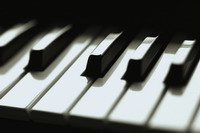Piano Sheets > Bach Sheet Music > Jesus, Joy Of Man's Desiring (Fragment) (ver. 1) Piano Sheet
Jesus, Joy Of Man's Desiring (Fragment) (ver. 1) by Bach - Piano Sheets and Free Sheet Music

About the Song
Jesu, Joy of Man's Desiring is the title of the 10th movement of the cantata Herz und Mund und Tat und Leben, BWV 147 composed by Johann Sebastian Bach. A transcription by the English pianist Myra Hess (1890-1965) was published in 1926 for piano solo and in 1934 for piano duet. Today, it is often performed at wedding ceremonies slowly and reverently, in defiance of the effect suggested by Bach in his original scoring, for voices with trumpet, oboes, strings, and continuo. Written during his first year in Leipzig, Germany, this chorale movement is one of Bach's most enduring works. Johann Sebastian Bach (pronounced ) (March 21; 1685 O.S. July 28; 1750 N.S.) was a German composer and organist whose sacred and secular works for choir; orchestra; and solo instruments drew together the strands of the Baroque period and brought it to its ultimate maturity.Although he introduced no new forms; he.
Download this sheet!
About the Artist

Random article
The essentials of piano sheet music Most people have the notion that sheet music is a very complicated notation and reading it very difficult. However, this is not true as understanding sheet music piano is just a matter of transcribing the various musical notes written.
Uses of sheet music
Piano sheet music is nothing but piano notes written in standard notations. You can avail such free sheet music online from various websites. The main use of sheet music piano is to help aspiring musicians recreate the same sequence of notes as performed by the composer of the piece. It is a method where a specific musical composition is recorded in written form using music notes. The ultimate aim of reading sheet music is to recreate the same score in as accurate a manner as is possible.
(More...)
